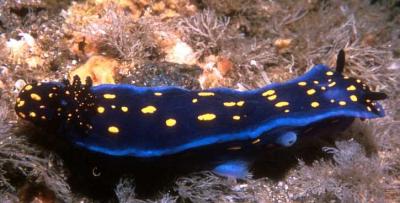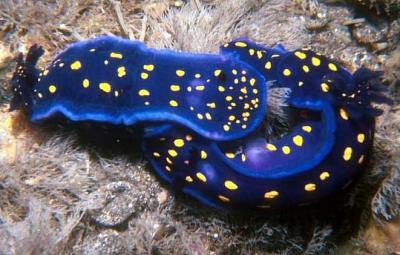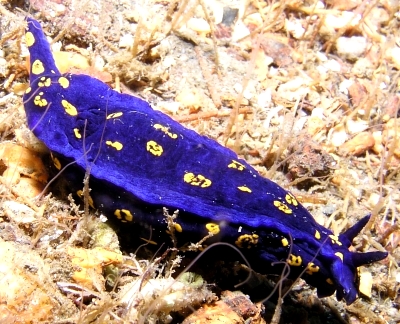

Hypselodoris californiensis
(Bergh, 1879)
Order: NUDIBRANCHIA
Suborder: DORIDINA
Superfamily: EUDORIDOIDEA
Family: Chromodorididae
DISTRIBUTION
Monterey Bay, California to Punta Eugenia, Baja California.
PHOTO
Santa Cruz Island, California. Photos: Scott Johnson.
A large dark blue elongate species with yellow spots arranged in rows down the dorsum and in a row down each side of foot. Margin of foot and dorsum a lighter cobalt blue. Gills and rhinophores blue to black. Similar in appearance to H. ghiselini but that species differs in having a darker blue background colour and smaller more numerous spots of yellow and white on the mantle and foot. There are also small white spots as well. There are yellow spots on the rhinophore clubs and the inside of the gills, and no paler blue margin. Grows to about 60 mm.
-
Bertsch, H. (1978). The Chromodoridinae Nudibranchs from the Pacific Coast of America – Part IV. The genus Hypselodoris. The Veliger, 21(2): 245-247.
-
Gosliner, T.M. & Johnson, R.F. (1999) Phylogeny of Hypselodoris (Nudibranchia: Chromodorididae) with a review of the monophyletic clade of Indo-Pacific species, including descriptions of twelve new species. Zoological Journal of the Linnean Society, 125: 1-114.
Rudman, W.B., 2000 (October 13) Hypselodoris californiensis (Bergh, 1879). [In] Sea Slug Forum. Australian Museum, Sydney. Available from http://www.seaslugforum.net/find/hypscali
Related messages
Hypselodoris californiensis from Santa Catalina Island
April 14, 2006
From: Jim Lyle

Dear Dr. Rudman:
While browsing throught the forum, an activity that I enjoy overly much according to my wife, I noticed that you only had one image of Hypselodoris californiensis.
A couple of years ago, we were diving at Catalina Island on the wreck of the Valiant when Judy Carlson found a new (to us) nudibranch, two large specimens within a metre of each other. Unfortunately, Roger's pictures came out a little blurry, but this was obviously a new discovery and images were quickly dispatched to Dave and Mike for identification. We were told that it was H. californiensis - a nudibranch that was commonly seen in Southern California waters thirty years ago, but had not been reported since. Two weeks later, we took the boat over to Catalina to see if we could find them again. We were successful, the two individuals were within a metre of each other, on the sandy bottom. Our pictures came out much better the second time. That was the one and only time that we have encountered this colorful branch.
Locality: Santa Catalina Island, 30 metres, CA, USA, Pacific Ocean, 03 March 2003, wreck/sandy bottom. Length: 15 cm. Photographer: Jim Lyle.
Best,
Jim Lyle
jlyle@adelphia.net
Lyle, J.L., 2006 (Apr 14) Hypselodoris californiensis from Santa Catalina Island. [Message in] Sea Slug Forum. Australian Museum, Sydney. Available from http://www.seaslugforum.net/find/16322Dear Jim,
Being interested in chromodorids, I've wondered why I haven't been sent more photos of some of these spectacular animals. I wonder what has caused the drop in their population?.
Best wishes,
Bill Rudman
Hypselodoris californiensis and underwater tantrums
October 15, 2000
From: Scott Johnson


Hi Bill,
Sending the yellow spotted Hypselodoris ghiselini recently caused me to think about the cooler water species from the coast of California, Hypselodoris californiensis. These two shots came from my very first dive trip in a temperate climate more than 20 years ago. On a trip to the US mainland from Hawaii, a friend took me out to California's Santa Cruz Island, promising that I'd see some large and spectacular nudibranchs. It was enough to make me brave waters considerably colder than I'd ever ventured into. When I dropped into the water and was sinking to the bottom, I admit I questioned my decision. But such questions vanished as I reached
bottom; from where I landed, I could see no fewer than 5 different species of large nudis, none of which I had ever before seen in the flesh. Ecstasy! Now I was glad I'd brought two cameras down with me. I had only one strobe, though, but it had an EO connector that allowed me to switch it from one camera to another under water. ……Unfortunately, the trip from Hawaii had jarred something in the strobe loose, so it failed to work with either camera. Ever see someone have a temper tantrum underwater? Out of the water, I was able to get the strobe working, so I did manage to get some pics. This was fortunate, since despite a fair bit of California diving in the mid '80s, I never again saw H. californiensis.
Scott
johnson@kmrmail.kmr.ll.mit.edu
Johnson, S., 2000 (Oct 15) Hypselodoris californiensis and underwater tantrums. [Message in] Sea Slug Forum. Australian Museum, Sydney. Available from http://www.seaslugforum.net/find/3175Dear Scott,
Thanks again. What a spectacularly beautiful blue. I'm glad you got the strobe working.
Bill Rudman.
